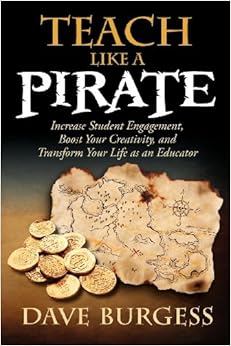
I had been hearing a lot about the book Teach Like a Pirate by Dave Burgess. The #tlap hashtag is everywhere in EduTweets and and there seems to be a lot of excitement surrounding it. Curious, I bought a copy from Amazon last week and it arrived the very next morning (I wish I could grade essays that quickly). I spent the day in the hammock reading and taking cursory notes (as suggested by the author).

The result? Wow. What a book. I can't really put into words how the book made me feel and how it made me think (I guess that's what I teach A&P and not journalism). I would not be able to do it justice. I was torn between re-reading it and taking really good notes or running with what I had learned, brainstorming more and starting to implement ideas. I really wish we had several more weeks of summer; not to put-off the first day of school, but to give me time to wrap my head around the myriad of ideas bouncing like a ping pong ball between my eight cranial bones.
So here are some ideas that originated from the book (tailored for my A&P classes). And that's really what this book is about: thinking about teaching and developing our classroom mindsets. Make our classrooms into places that students want to come to and not have to come to. It's a pretty cool feeling when students opt to stay in your room in lieu of attending an optional assembly, isn't it? I want to experience that more often.
I took my brainstormed list of ideas, developed them and categorized them into 5 sections:
- Beginning of semester
- Beginning of unit/day
- Middle of unit
- End of unit (review)
- Miscellaneous
- at the beginning of the semester, line-up students. step forward/back if they have been impacted in some way by a family member or friend who has a history of diabetes, sickle cell, heart disease, cancer, Alzheimer's, seizures, cardiac arrest, hypertension, congestive heart failure, cerebrovascular accident, muscle cramps, dehydration (this visually and kinesthetically demonstrates the connection that Ss will have with our areas of study and promotes buy-in and authenticity)
- 1st day sort students into areas of expertise (such as Google Docs/Sheets/Forms/Slides/Mail/Draw/Drive/Hangout, video/pict media, artistry, etc...) for work groups. Goal is to have one "expert" in each work-group.
Beginning of unit/day:
- create a board message hook to create buzz before bell even rings (or project just a QR code on board)
- Before starting a new chapter present and discuss a case study (like pediatric fractures before skeletal system: growth plate involvement, bone anatomy, bone development, fracture repair)
- Ss use Coggle.it to diagram and explore the various pathologies behind findings on physical exam (skin linked to pale, flushed or cyanotic) then each finding (e.g. cyanotic) is explored more deeply (physiological causes). Used as intro, Ss discover the "backstory" behind why we are earning xyz:
Middle of unit:
- Ss use Coggle.it to create mind maps of a disease of their choice (etiology, signs, symptoms, risk factors, diagnosis, treatment, prognosis):
- Ss create and teach a dance to class (show Richard Simmons video, use for directional terms, body regions, abdominal quadrants and bone identification)
End of unit (review):
- end of unit review assignment for all of Gardner's multiple intelligences (outline chapter, poem, rap, sketch, 3D art project, song, video summary like a dance, etc...)
- create a review dance video at end of unit
- play Pictionary, charades for review, Jeopardy (use Flippity.net and Google Sheets in lieu of PPT; have Ss work groups make their own Qs and As then put all together):
Miscellaneous:
- later in the semester, Ss have labels (hpi, pmhx, meds, aller, ros, pe, vs, differential diagnoses, clinical impression) and sequence themselves in order of logical progression
- Ss change lyrics of a song to learn course content (isn't it ionic, don't you think?)

- best dissection group gets to be guest Pandora DJ for the following day (revisit dissection rubric --> daily dissection grade)
- create something real for world to view and comment on (Google Sites dissection log):
- periscope.tv between classes in different buildings, districts, states or countries (show elementary kids what we do in the high school? compare dissections in different A&P classes through the world!)
- daily GHO w/ other A&P classes to compare notes/summarize the day?
- post articles of potential interest on wall with QR codes for Ss to scan
- black bin with 2 hand/arm holes (or use a tri-fold) hiding content from Ss; use tactile sense to distinguish between radius, ulna, humerus, scapula, clavicle, atlas, axis, lumbar vertebra, coxa, femur, tibia, fibula
- Ss problem work through/solve a mini case study in groups every day without much T help
- competitively perform a task or solve a problem using Survivor theme (tribes) or Amazing Race theme (partners)
- random student name picker (wheel of fortune type thing? digital/IWB?) - use Flippity.net (can place Ss randomly into pairs, groups, pick one, etc):
- anatomical digital scavenger hunt using Ts and Admins and Ss throughout the school (e.g. T's right femur, AP's distal antebrachial, lunch cashier's medial malleolus); post picts with label and explanation to Twitter using common hashtag (use Alice Keeler's Twitter Sheet)
So, that's about it. For now. PLEASE feel free to comment and offer-up suggestions. Interested in Periscoping or GHOing with my classes this year? Contact me!
No comments:
Post a Comment